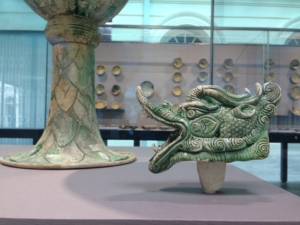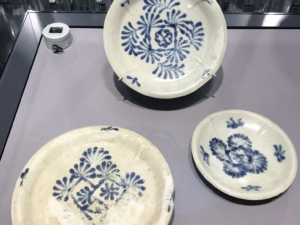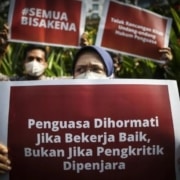
Green-splashed stoneware dragon-head stopper and detail of an oversized ewer. Photo by Natali Pearson.
In mid-1998, as President Suharto’s regime crumbled and Indonesia began the long process of unwinding decades of authoritarian rule, local fishers made a thrilling discovery – a 9th century shipwreck in waters near Belitung Island.
The nature of the cargo – some 70, 000 objects, most of which were ceramic bowls from the kilns of Changsha in China – testified to production and export on a massive scale. The vessel itself – specifically the distinctive construction technique, whereby the timber planks were sewn, rather than nailed, together – hinted at connections with the western Indian Ocean world.
Little did the fishers know the Belitung shipwreck was one of the most significant – and controversial – maritime discoveries of recent times, offering new insights into oceanic trade networks across the globe and drawing attention to the complexities of managing shared maritime heritage. Archaeologists and historians were particularly drawn to what the vessel and its cargo revealed about the exchange of ideas, technologies and materials between China and the Middle East in the 9th century.
Three shipwrecked stoneware saucers, for example, were lauded as early prototypes of the famed blue-and-white ceramics Chinese potters would only master many centuries later. Featuring cobalt lozenge designs on a white background, these saucers added weight to the notion that the vessel and its cargo were destined for the Middle Eastern market.

Three stoneware dishes painted in cobalt blue from the kilns of Gongxian, circa 830 CE, considered early precursors to China’s famed blue-and-white porcelain. Photo by Natali Pearson.
This was, to paraphrase commentators at the time, a glorious story of early globalisation, characterised by trade and exchange across vast geographies. But where was Indonesia in this story of ancient oceanic connection?
Indonesia – the shipwreck wholesaler
Indonesia’s role was a curious one, defined not by its centrality within global maritime histories but by contemporary agreements regarding the management of marine space. Irrespective of its origins or destination, the vessel had sunk in what would become Indonesian territorial waters. As such, it was Indonesia that was entitled to determine how the Belitung wreck would be managed.
Indonesia’s approach to shipwreck management had long placed it at odds with the international community, which was moving toward the development of a dedicated convention on the protection of underwater cultural heritage. Contrary to these international standards, however, which preferenced in situ preservation and firmly opposed any form of commercial exploitation, Indonesian laws permitted commercial operators to survey and salvage shipwrecks in its territorial waters. This system, which was first introduced in 1989 and endured until 2010, allowed for profit-sharing between the Indonesian Government and the salvage company.
Over two seasons, therefore, and in accordance with Indonesian law, a commercial salvage company recovered approximately 60,000 objects from the seabed: ceramics mostly, but also gold, silver, bronze and even organics such as resin and star anise, all of which had survived 1100 years underwater.
After extensive conservation and a major marketing campaign, some 53, 227 of these objects were sold to Singapore in 2004 for USD$32 million. Upon receiving the objects, Singapore re-branded them as the Tang Shipwreck Collection, emphasising in no uncertain terms the wreck’s Chinese connections and, in the process, erasing Indonesia’s.
The remaining 7,000-odd objects were seized by Indonesian authorities following an ownership dispute with the salvage company. To this day, the seized objects remain under lock and key at a shipwreck artefact warehouse in Cileungsi on the outskirts of Jakarta. They were an indicator of the looming controversy to come.
Singapore – the shipwreck exhibitor
Singapore, as the new custodian of the collection, had its work cut out. How to care for so many objects? Where would they be displayed? And perhaps most challenging of all: what was the narrative around these objects, and how did Singapore fit in? With its Chinese cargo, Middle Eastern connections and Indonesian find spot, Singapore’s sole claim to the shipwreck was pecuniary. Was that enough to build an exhibition?
The answer, as it had to be, was yes.
In 2011, Singapore launched a major international exhibition of the Collection. Shipwrecked: Tang Treasures and Monsoon Winds was to open first in Singapore before travelling to the Smithsonian Institution in Washington D.C. But just months ahead of the planned opening – an impossibly short amount of time, as any museum curator will confirm – the Smithsonian cancelled the exhibition, citing concerns around the commercial means by which the objects had been recovered. The salvage may have been legal, they argued, but recovering shipwrecked objects for profit was not ethical.
The ensuing controversy, echoes of which continue to reverberate in curatorial and archaeology circles to this day, saw criticism directed not only at Singapore, for purchasing the objects, but also Indonesia, for legalising their sale.
The debate is an important one. Is it possible to exhibit commercially salvaged objects without legitimising treasure hunting? What is the best way to protect underwater cultural heritage, and to enable access for members of the public, scholars, and future generations?
Shipwreck policy – an unenviable job
Equally important, however, are the lingering questions the Belitung shipwreck poses for Indonesia. How did a collection of this significance slip through its fingers? What are Indonesia’s rights and responsibilities when it comes to managing the thousands of shipwrecks in its waters? And why, in the world’s first (and arguably greatest) archipelagic state, has maritime heritage for so long been framed primarily in terms of its economic, rather than its historical or archaeological, value?
Indonesia is still grappling with these issues.
Rather than becoming more streamlined, the regulatory framework for shipwreck management has become more complex. The 2010 moratorium on commercial salvage was overturned in 2020 by the Job Creation Law – but uncertainty about the constitutionality of the Job Creation Law has created further ambiguity.
Within this legislatively complex environment, those tasked with shipwreck management – particularly in the Ministry of Education and Culture and the Ministry of Marine Affairs and Fisheries – have an unenviable job.
The shipwreck artefact warehouse in Cileungsi has swelled to over 220,000 seized objects, all of which need cataloguing and conservation.
At the same time, internal capacity has improved, with more trained maritime archaeologists and researchers throughout government.
There is also a growing awareness of the value of maritime heritage in supporting local tourism and livelihoods, and of its potential as a geocultural resource – look no further than Indonesia’s revitalisation of the Spice Routes concept as counterbalance to the discursive supremacy of China’s Maritime Silk Road narrative.
Protecting the past in a maritime future
Curator John Guy observed that sometimes “an event occurs which dramatically enlarges the boundaries of our knowledge and raises our understanding of the realities of the past. The discovery of the Belitung shipwreck is one such event.” Equally, however, the shipwreck has raised our understandings of the realities of the present, in particular the politics of maritime heritage and the complexities of managing shared heritage within international and national frameworks.
Not only is Indonesia central to global maritime histories, its geo-strategic position is such that it is also central to global maritime futures. Shipwrecks such as the Belitung ship, and the many thousands more that lie in Indonesian waters, are essential tools for understanding how the past is being used to lay claim to the future.
But as enticing as shipwrecked tales of treasure and tragedy are, the romance of shipwrecks can be a red herring. Dive deeper and it turns out that Indonesia’s shipwrecks have much to tell us about the world we live in today: about capacity and resource imbalances between the global north and south; about the relationship between heritage, tourism and livelihoods; about legislative inefficiency; and about the use of heritage to accumulate and articulate power in an increasingly contested region.










 https://www.flickr.com/photos/justcallmemo/14939478732/
https://www.flickr.com/photos/justcallmemo/14939478732/